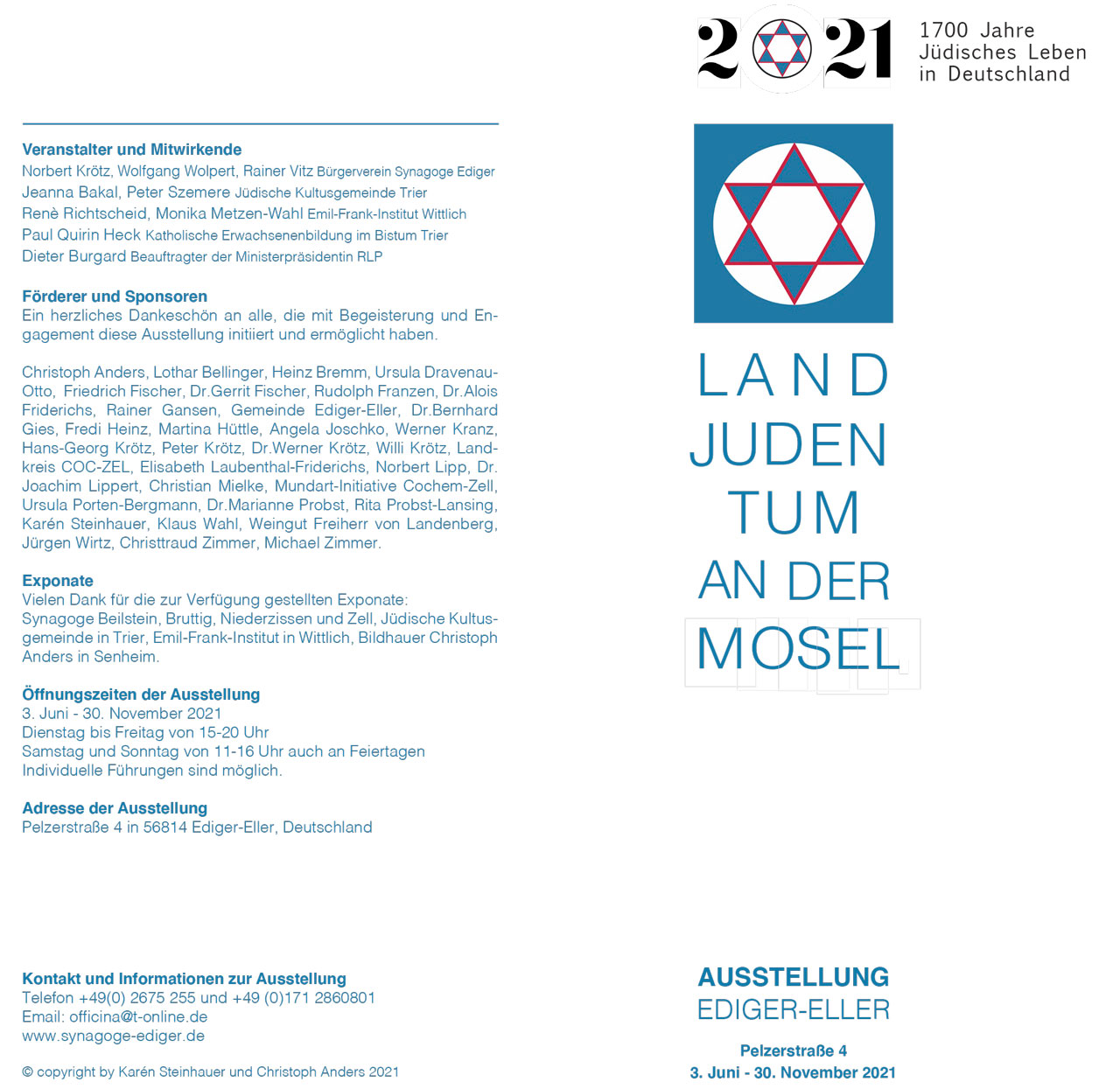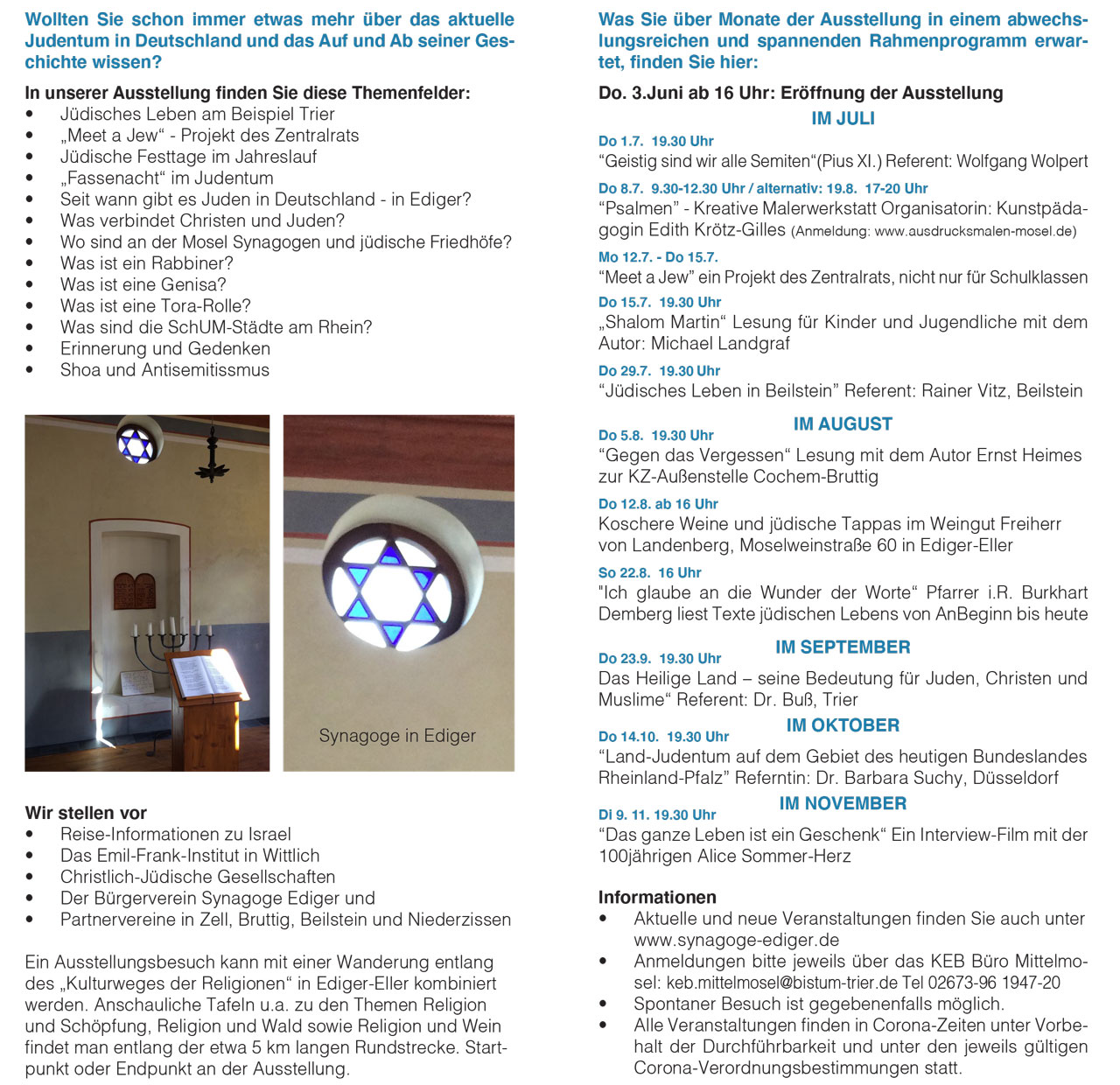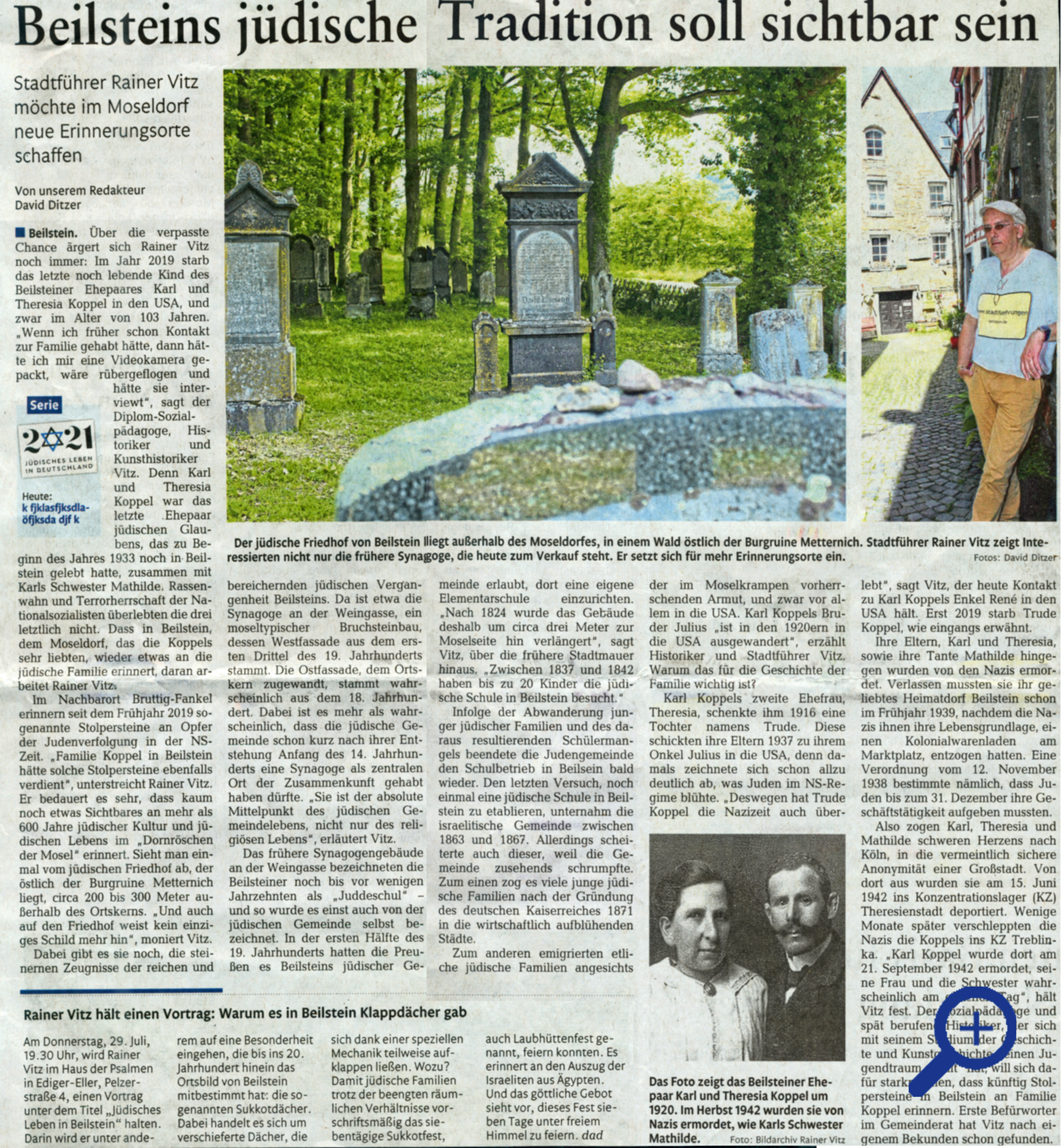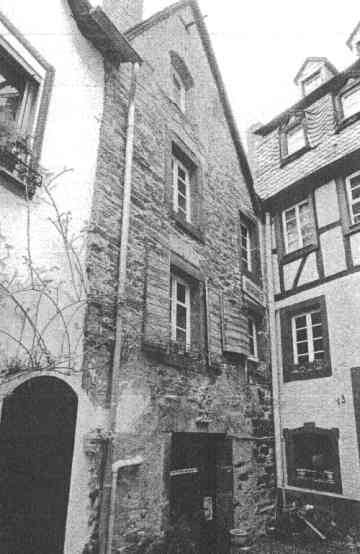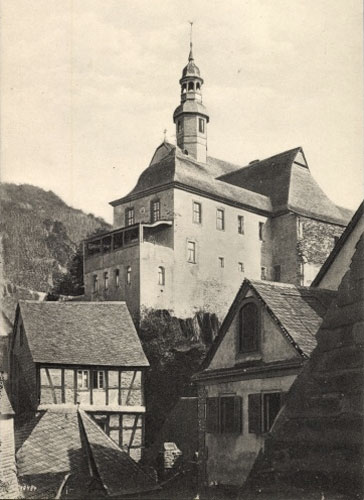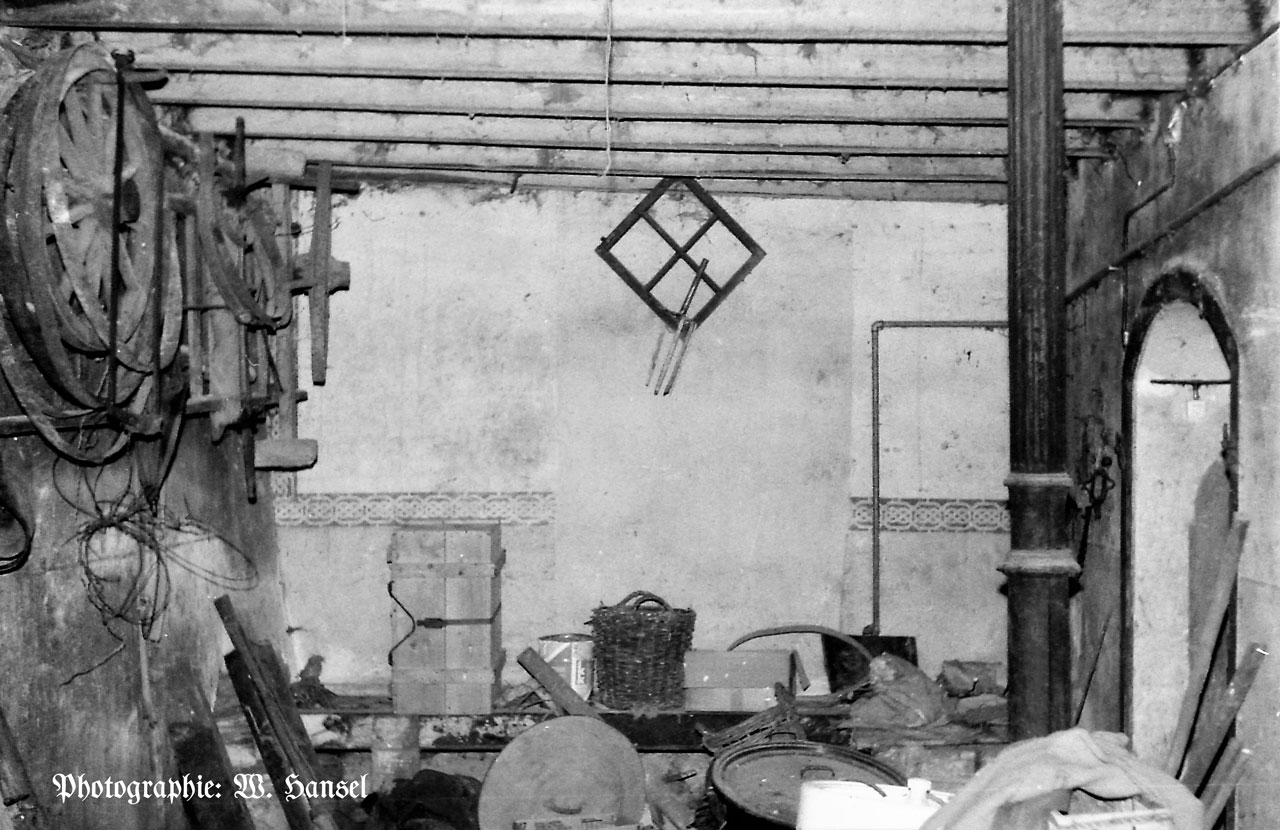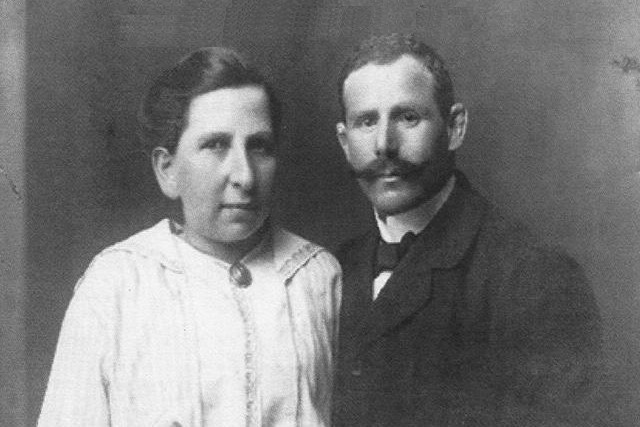Beilstein and its Jewish community
by Rainer Vitz
Jewish life in the late Middle Ages
Since the beginning of the 14th century, i.e. the late Middle Ages, Beilstein was the place in today’s Cochem-Zell district with the most important Jewish community.
The life of a Jewish minority in the Christian majority society in the late Middle Ages and early modern times was shaped by numerous problems with this majority society and the authorities, which were of course also Christian. Far more than their Christian neighbors, the Jews were to a large extent dependent on the benevolence of their rulers. Right up to the 16th and 17th centuries, the right of residence was always unsecured and had to be renewed again and again with the purchase of letters of protection – which sometimes existed until the 19th century.
The coexistence with the Christian neighbors was characterized by the centuries-long Christian defamation of Judaism as the „religion of the murderers of God and unbelievers“.
So it was obvious that the Jews, especially in the cities, but sometimes also in the much smaller Jewish rural communities, as Beilstein exemplifies, strived for a certain autonomy and self-administration. The large Jewish communities such as Trier, Mainz, Worms, Speyer etc. organized themselves in their own communities, some with their own jurisdiction, welfare institutions, funeral societies, schools, hospitals, etc.
In the small rural communities with far fewer community members, this was as difficult. Autonomy was granted by the authorities only as far as it seemed useful to them. That was often the case in taxes and charges. The Christian rulers had it easier to settle the desired duties and taxes directly with the Jewish community than with each Jew individually.
At the same time, the Jews were in constant contact with their Christian counterparts in everyday life. Be it as a neighbor, dealer, beggar or business partner. People met on the street, in the market or in the pub. This ambivalent relationship made the Jews appear as wanderers between the worlds. In the large Jewish communities of the early modern period, contact between Christians and Jews was sometimes poor. In the small rural communities, this everyday contact could not be avoided at all. Beilstein, with its geographically very limited territory, is a very exciting example.
What motivated Johann von Braunshorn in 1310 to allow the 10 Jewish families space for their settlement exclusively behind the northern and partly western city walls is difficult to say today. It is unlikely that he provided for a closed ghetto (that is, a separate and lockable area of the city) for the Beilstein Jews. The two overbuilt gates, which are sometimes referred to in research in Beilstein as the entrance and exit gates of the Jewish quarter, are much more recent.
It is more likely that Johann von Braunshorn combined the granting of Jewish settlements with the construction and maintenance of the city wall in this part of Beilstein in 1310. It should also have been easy for the settled Jews to separate themselves to a certain extent in the north-western part of Beilstein. A separation was not necessarily prescribed by the authorities, but was also in the interests of the Jews themselves.
Completely different cults, different holidays, different types of festivals, eating habits, prayer times, a completely different social structure, none of this made living together between Christians and Jews in the immediate vicinity conflict-free. Living together with Jewish neighbors has certainly made everyday life here easier. (The term ghettoization should not be used before the beginning of the 16th century, as it refers to the banishment of Sephardic Jews to an offshore island in Venice from around 1500).
The settlement of the Jewish community in Beilstein in 1310
The first important ruler on Beilstein, Johann von Braunshorn was the steward of King Heinrich VII, had served him well and was very close to him.
Heinrich granted him town charter in 1309/10 and approved the settlement of 40 citizens and 10 Jewish heads of household with their families. The number of 10 families was no coincidence – an independent Jewish community with regular worship could only be founded with the existence of the so-called Minjan (i.e. ten or more men of age in the religious sense). Heinrich VII also had an interest of his own in founding the Jewish community in Beilstein. Ten other protective Jews flushed various income (body duty, coronation taxes, tolerance money for staying in the Reich and other taxes) into his coffers. Johann von Braunshorn was also pleased about the collection of various taxes that he received from the Jews. In the first year alone, the umbrella money imposed on the Jews amounted to 16 Cologne silver marks. The settlement of the Jews at the very beginning of the founding of the Beilstein city was therefore primarily due to fiscal / economic reasons.
Most of the Jews who came to Beilstein in 1310 came from the Middle Rhine, especially from Oberwesel. In the Oberwesel / Bacharach area there have been repeated allegations of ritual murder against Jews since 1287. They were accused of murdering the 16 year old vineyard worker Werner in 1287 in order to use his blood at the Passover festival. As a result of these absurd anti-Judaist accusations and the associated pogrom mood, numerous Jews left Oberwesel.
The Beilstein Synagogue
It can be assumed that the ten Jewish families quickly endeavored to build their own house of prayer in the territory assigned to them. A separate place of prayer (Greek: synagogue, means something like house of gathering), unlike a Christian church, is not a consecrated place with an exclusive worship function, but often a multifunctional room. A Jewish worship service could theoretically take place anywhere in the world. The only requirement is the presence of the minjan and certain cult objects.
If you take into account that the synagogue (especially in the small Jewish rural communities) was mostly used as a teaching room for teaching the Torah, that weddings, family celebrations and other Jewish festivals were sometimes celebrated here, it is highly likely that the Beilstein Jewish community from the beginning ie from 1310 sought such a meeting house. It will certainly have built this in the Jewish quarter as well. Whether that house now stood in the same place where the building of the former synagogue is today (Weingasse 13) is one of the most interesting questions that the historian in Beilstein asks himself today.
The building with the dimensions 6m X 5.50 meters was initially connected directly to the Moselle side i.e. western city wall. At the beginning of the 19th century, the plots on the city wall were divided and an extension beyond the wall was approved.
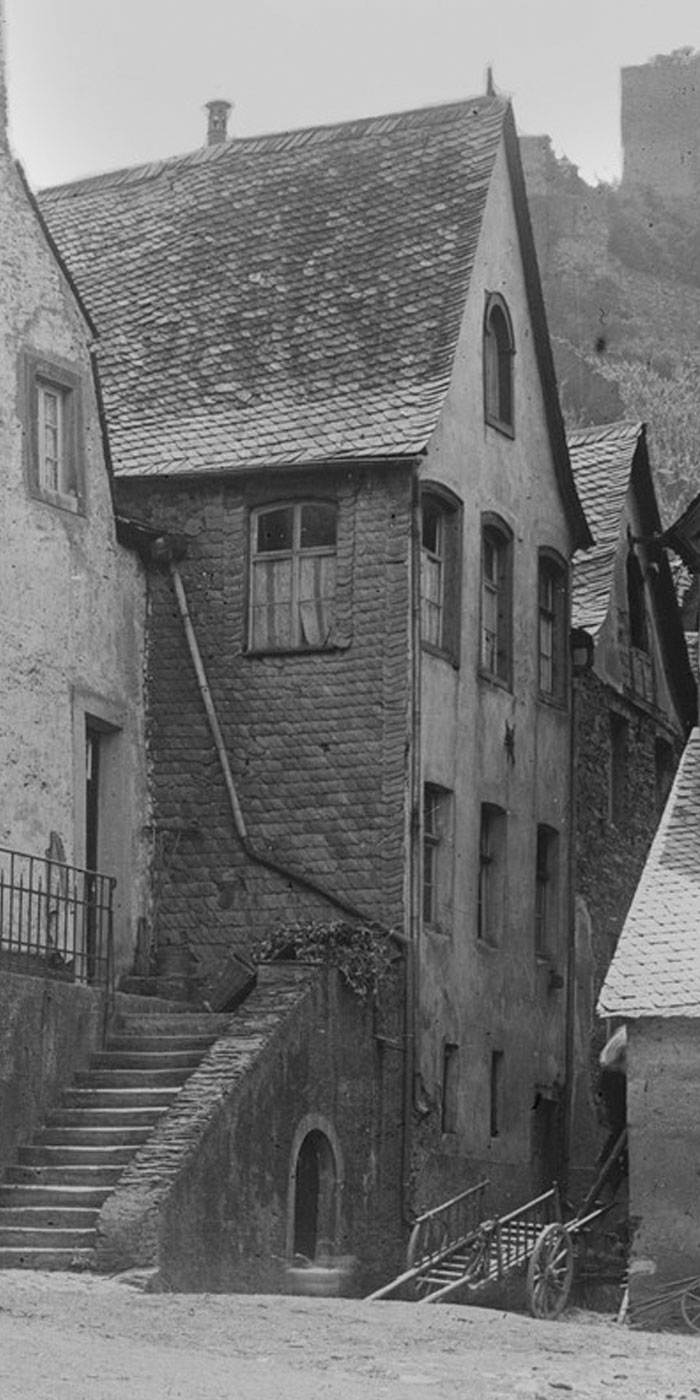
Extension part with glazed north façade.
The synagogue was thus lengthened by about 3 meters to the west, which considerably enlarged the worship room, but also the women’s gallery.
The enlargement of the synagogue goes hand in hand with the increasing importance of the Beilsteiner Jewish community at the beginning of the 19th century.
A few figures may illustrate this:
The first reliable population census from 1807 (at that time our area was part of the French state) gives a figure of 47 Jewish residents.
In 1818 there were already 73 Jews living in Beilstein and thus made up around 30% of the total population.
Even 40 years later, 79 Jews were still counted in Beilstein. From the 1870s onwards this number declined continuously.
On the one hand, this can be explained with strong waves of Jewish emigration, especially to the USA.
Secondly, with the economic upswing at the beginning of the German Empire, which drew many rural Jews to the urban centers with their better earning and training opportunities.
A mikvah in Beilstein?
A mikveh, i.e. a ritual immersion bath, has belonged to a Jewish community since ancient times. The mikvahs were not used for purification i.e. Body care but the ritual liberation from „impurities“, which include certain body fluids, but also contact with the dead. Attending the service was sometimes not possible without visiting the mikveh.
A Jewish community with a rich Jewish life and synagogue, as was the case in Beilstein, is hard to imagine without its own ritual bath. It is very likely that the Beilstein Jewish community owned such a mikveh. At this point only the important mikveh in the Bruttig synagogue should be mentioned; and the Bruttig Jewish community was much smaller than the Beilsteiner community.
Taking into account these circumstances and the importance of the Beilsteiner Jewish community for the entire Moselkrampen, it can be considered almost certain that the synagogue had its own ritual ritual bath. The supply line with „living water“ (that could be groundwater, spring water, rainwater, but also all other flowing water) was given by the nearby Hinterbach (today overbuilt with the bypass road Alte Wehrstraße). Depending on the groundwater level, this supply line wasn’t even necessary. This ritual basin was probably located in the barrel-vaulted cellar of the synagogue building and was well connected to the worship room by two flights of stairs. Here, too, an examination of the building history would provide certainty as to what was hidden under the concrete screed that was laid in the 1920s.
The Beilsteiner Jewish School
Interestingly, the synagogue was called „Juddeschull“ by all Beilsteiners until a few decades ago. This is not a Christian name but was the Jewish title for this building.
Traditionally, learning and teaching are of great importance in Judaism. Not only the dispute and the interpretation of religious scriptures were important to the Jews, it was also considered important to impart language skills, arithmetic, writing, geography and natural sciences to the children, especially the boys.
With the introduction of compulsory schooling in the Prussian Rhine Province in 1824, the Jewish communities were also allowed to set up public denominational schools. The Jewish community of Beilstein, which was already quite important at that time, took advantage of this opportunity and expanded the synagogue building in the following years on the Moselle side beyond the former city wall by almost three meters.
The space that was created was now adequately lit by four new windows and offered space for around 20 school children. Raphael Marx, the first teacher mentioned by name, taught up to 20 Jewish students between 1837 and 1842. His successor was Samuel Borek in the same year. But in the following year, in 1843, teacher Borek Beilstein left again. Above all, the emigration of young families caused the number of school children to drop to 12. Under these circumstances, the Beilsteiner Judengemeinde could no longer pay its own teacher and closed the school. Once again they tried to set up their own Jewish school.
Between 1863 and 1866 the Israelitische Gemeinde zu Beilstein advertised a Jewish teacher which was finally found in the person of Karl Simon. But a year later, in 1867, he was released. Simon was the last teacher in the Jewish Beilsteiner school. After that, the community finally gave the attempt to run its own school, especially since the entire Jewish community suffered from a loss of importance and became smaller and smaller. From 1867, the Jewish children attended the Catholic village school in the Beilsteiner Bürgerhaus on the market square.
The Jewish cemetery
The Beilstein Jewish cemetery is located east of the castle in a small wood, about 300 meters outside the town center. It was probably created in the 17th century.
Not only the Beilstein Jews buried their dead here, but also families from the nearby Senheim, Mesenich, Ediger-Eller, Bremm and Bruttig.
A cemetery is an extremely important place for a Jewish community, as it is designed for eternity and must never be used for another purpose. The relocation of a grave site is absolutely unthinkable according to the Jewish cult and the rules of Halacha. Ownership of these properties was always very important to the Jewish communities and, if possible, expansion areas were also kept available, since a Jewish cemetery had to expand in size over the decades and centuries.
In Beilstein, the oldest still legible tombstone is at the northern tip of the area (towards the castle ruins). A Rafael, son of Moshe, who died on November 10, 1818, found his resting place here. The rows of graves taper towards the south and reveal a stele for Eva Simon from Bruttig, who died on January 1st, 1938, as the youngest burial place. After that there were no more funerals. After the pogrom of November 1938, more and more Jewish families emigrated from the district.
Those who did not make it in time were deported to the concentration camps from 1941/42. As a result, the cemetery was left to its own devices and nature took hold of it, which to a certain extent also corresponds to Jewish tradition. There was probably no targeted desecration or destruction during the Nazi era. What is striking, however, in many grave stelae is the lack of internal inlay panels – often made of marble or cut granite. These plates with grave inscriptions, dates of birth and death are hardly available today. Whether the Nazi era with its anti-Semitic acts and excesses was the cause here can only be guessed today.
Sukkot roofs in Beilstein
The so-called „Sukkot roofs“ in Beilstein were a peculiarity that should have strongly determined the townscape of Beilstein until the beginning of the 20th century. T
This was a special technical feature that made it possible to open up parts of a slid roof structure. This peculiarity could be explained by the Jewish law requirements on the one-week Jewish festival of Sukkot.
The seven-day Sukkot festival, or Tabernacles Festival, is celebrated by the Jews in the autumn; originally as a Thanksgiving feast, later also as a reminder of the exodus of the Israelites from Egypt under the leadership of Moses. (approximately 3300 years bc). During the 40-year desert walks, the Israelites lived in tents or makeshift huts. The stay of the Jewish family during the Sukkot holiday in such huts, which were mostly built of branches, wickerwork, foliage, straw, etc. and covered with a temporary translucent roof of branches and foliage, was intended to recall this deprivation-rich time.
The Sukka hut had to stand outside and allow the view to the starry sky. This was very difficult however for the Jewish Beilsteiners in the centre of the village to fulfil. After all, very few houses had a courtyard, garden or similar at all.
Beilstein Jews implemented the divine commandment to live seven days in the open air in a highly creative form by providing the slate-covered saddle roof with a mechanism that made it possible to open parts of the roof.
They then lived in the attic for a week, often in a specially designed room. An even more skilful solution, which can be proved in Beilstein at least in two houses, was the following: The Jewish family did not move to the attic, but remained in their normally used rooms throughout the festival. The requirement to stay under the starry sky was met by removing recesses in the ground (in one case on three floors) and thus even being able to use the ground floor area. In the middle of the 19th century there must have been about a dozen of these Sukkot roofs in Beilstein. The last two (the former youth hostel and the present inn „Gute Quelle“, both located on the market square) were destroyed by renovation of the roofs in the 1950s and 1960s.
Disintegration of the Jewish community
In the last third of the 19th century, the Jewish communities in the district fell apart. This development also applied to Beilstein. The emancipation of Jews in the Wilhelmine Empire from around 1871, but also increasing assimilation, allowed young families in particular to move to the Prussian metropolises.
As rural Jews, they no longer saw a future worth striving for in the lives of their fathers and grandfathers. There was an increasing aging of the Jewish communities in the area, which was also evident in Beilstein. While there were up to 20 Jewish schoolchildren in the area in the 1830s, the idea of having its own Jewish school was abandoned in 1867 due to the lack of sufficient students. .
In 1840, with a total population of 299, a total of 79 Jews lived in Beilstein, but shortly after the First World War their number had shrunk to a few people. The Beilstein synagogue probably saw the last Jewish service before the First World War and the community was forced to officially dissolve and part with the last religious objects. In an advertisement from April 16, 1920 published in the „Jüdischer Boten vom Rhein – Jüdisches Wochenblatt“, the Israelite community in Beilstein offers various religious objects, books and even a Torah scroll for sale due to its self-dissolution.
A few years later, Sigmund Lipmann also sold the synagogue building in Weingasse. The Jewish community in Beilstein, which had existed for more than 600 years, no longer existed.
The new owners kept their cow in the cellar and also some pigs. The worship room, with its original height of about six metres, received a newly inserted beamed ceiling at the level of the women’s gallery. The upper part was used as a hayloft, while the lower part was used as a winepress and storage room between 1925 and the 1970s. The photo shows the beamed ceiling and, to the east, the former toranic room, which has already been bricked up and plastered over.
The time of Nazi persecution
With the transfer of power to the NSDAP on January 30, 1933, life for people of Jewish faith in Germany gradually became unbearable. At the beginning of 1933, only Karl and Theresia Koppel and Karl Koppel’s sister lived in Beilstein from the formerly large Jewish community in Beilstein. The winery owner and innkeeper Sigmund Lipmann had died the year before, in 1932. All other Jewish families had moved from Beilstein between 1900 and 1930.
The Koppel couple ran a small grocery store on the market square. Just three days after the pogrom of November 9, 1938, all Jews in Germany were prohibited by law from owning shops and businesses. The Koppels grocery store on the market square was Aryanized at the end of 1938. In the spring of 1939 Karl Koppel moved to Cologne with his wife and sister Mathilde Koppel; in Beilstein they had been deprived of their livelihood.
Three years later, on June 15, 1942, the Koppel family was on the second large transport from Cologne to the concentration camp or forced ghetto Theresienstadt. This deportation train with the designation III / I comprised 963 people who were crammed into cattle wagons for the first time and then transported from Cologne. The train was hastily assembled in order to quickly create replacement living space for the “German-blooded” Cologne residents who were bombed out on May 30, 1942 during the great bombing raid on Cologne. A few months later, the Koppel family was deported to the Treblinka concentration camp. Karl Koppel was murdered there on September 21, 1942, his wife and sister probably on the same day.
According to the current state of research, 14 people of the Beilsteiners of Jewish faith who lived in Beilstein around 1900 were murdered in the concentration camps during the period of German fascism. However, there were no deportations from Beilstein, as these Beilsteiners had left the place years earlier.
Sigmund Lipmann’s son, Wolf Lipmann, born in 1910, had a non-Jewish mother in addition to his Jewish father. According to the racist Nuremberg Laws of September 1935, he was considered a so-called “half-Jew”. This was a status that saved some of those affected from deportation and extermination for a while. Nevertheless, Wolf Lipmann was subject to various restrictions and reprisals. However, his status classified him as „unworthy of defense“ and he was not drafted into the Wehrmacht.
That changed at the end of the war. In February and March 1945 children, war invalids and then also „unworthy of military service“ were drafted into the German Army. This last contingent of the so-called Volkssturm was supposed to stop the advancing Americans. Together with a 15-year-old boy, finally Wolf Lipmann was recruited for the Volkssturm in Beilstein. Both felt little desire at the end of the war to give their lives senselessly and hid in a vineyard hut for a few days until mid-March 1945. Of course, in Moselkrampen you could also secretly listen to the British radio station BBC and know that the liberation by the American army would only be a few days away. The relatives provided the two of them with food for a few days and so after the end of the war the rather „strange“ story arose that the Beilsteiners had protected their Jews during the Nazi era.
What is still reminiscent of the Beilstein Jewish community today?
If you realize how important the Jewish Beilsteiners were for the place for more than 600 years, it is very sad how little is remembered of the Jewish Beilstein today.
The Jewish cemetery is outside of the town center and very few tourists see it. There is also no longer any reference to this cemetery in the town center. The former synagogue, now partially used as an art gallery, has a small private museum on the history of Beilstein and his Jews inside, but is also hardly noticed. A small sign on the outer wall, which pointed out the former function of the building, was removed a few years ago after it was smeared with a swastika and was not re-attached by the Beilstein community.
After the conversions and renovations of the last few decades, not a single one of the previously existing fold-out Sukkot roofs has survived. The house, as well as the commercial building of the Koppel’s grocery store, are still standing, but here, too, nothing points to the former owner family and their cruel fate. Perhaps Beilstein should take an example from the history of the neighboring municipality of Bruttig. In the year of Bruttig-Fankel, the Cologne artist Gunter Demnig remembered the murdered residents during the Nazi dictatorship with his project “Stolpersteine”. That would suit Beilstein too. After 80 years of repressing and forgetting, not only the Beilsteiner Koppel family deserves to be remembered.
The topic “Beilstein’s Jewish history” contitutes an important part of the “Historical City Tours 700 Years of Beilstein”, which the author regularly conducts in Beilstein.
Private guided tours for groups as well as individuals can be booked and tailored on request to focus more in-depth on Beilstein’s rich and fascinating Jewish past. Jewish heritage tours of other nearby villages in the Mosel area can also be arranged.
Information on this: www.stadtfuehrungen-beilstein.de
Literature and sources:
Schleindl Angelika: Traces of the Past – Jewish Life in the Cochem-Zell District. Briedel 1996
Wendling Wolfgang: The Jewish population in the district of Cochem Zell in the 19th century. In: Jahrbuch Kreis Cochem 1986, pp. 226-231
Hansel Wilfried: The Jewish school in Beilstein – with a contribution by Otto Münster. In: Jahrbuch Kreis Cochem-Zell 1988, pp. 99-102
State Office for Monument Preservation Rhineland-Palatinate (Ed.): … and this is the gate of heaven – Synagogues Rhineland-Palatinate Saarland. Mainz 2005
Renard Prof. Dr .: In: Rheinischer Verein für Denkmalpflege und Heimatschutz (Ed.) 9th year, Heft3, pp. 149-158 Contribution to Beilstein. Düsseldorf 1915
Gottwaldt Alfred u. Schulle Diana: The deportations of Jews from the German Reich 1941-1945. Wiesbaden 2005
Schommers Reinhold: The Beilsteiner Jewish community and its synagogue. In: Sobernheimer Talks III The country on the Moselle Culture and structure. Bad Sobernheim 1995
Vogts Hans: Art monuments of the Rhine province – volume circle Zell. P. 55-79 article on Beilstein Düsseldor 1938
Hönl Joh .: The story of Beilstein. Without place 1978
Kahlki J .: Beilstein the Sleeping Beauty of the Moselle. Cochem, no year
Regesta of the archives of the Winneburg-Beilstein rule in the total archive of the Princes von Metternich in the state central archive in Prague. Documents up to 1400, edited by J. Mötsch. Koblenz 1989
Web sources:
From the history of the Jewish communities in the German-speaking area www.juedische-gemeinden.de (accessed on July 5, 2019)
On the history of the Jewish community of Beilstein www.alemannia-judaica.de (accessed on July 5, 2019)
Landschaftsverband Rheinland: Synagogue in Beilstein www.KuLaDig.de (accessed on July 5, 2019)
Rainer Vitz: Beilstein in the past – historical city tours 700 years of Beilstein www.stadtfuehrungen-beilstein.de (accessed on July 5, 2019)
Ausstellung „Landjudentum an der Mosel“ in Ediger-Eller
